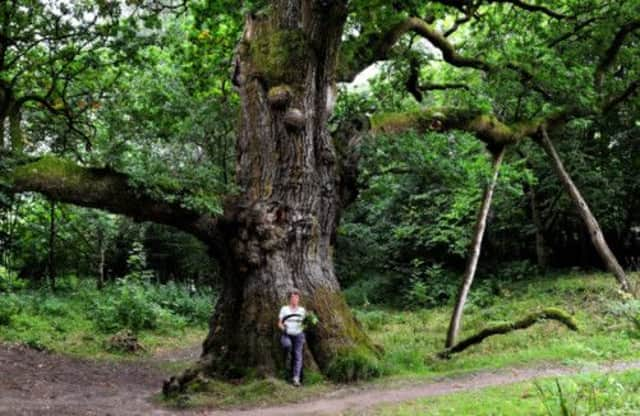Killer weed endangering Birnam Wood ancient oak


But now the most ancient survivor of the original Birnam Wood is in danger of being killed off by exotic weeds, which are spreading across Scotland.
The 1,000-year-old Birnam Oak in the Perthshire woodland is surrounded by the invasive Himalayan balsam (Impatiens glandulifera), which crowds out native species that help protect the tree by preventing soil erosion.
Advertisement
Hide AdAdvertisement
Hide AdA concerned resident is now waging a one-woman war to save the historic tree, but experts fear the ancient oak could be lost forever unless those responsible for dealing with invasive species take more urgent action. Katharine Melville, a retired social researcher and environmental volunteer from Little Dunkeld, said: “I first noticed the Himalayan balsam some years ago because it is extraordinarily pretty. It has really increased in the past three years and this year I just could not stand the sight of it any more, so I decided to do something.
“I asked Scottish Natural Heritage [(SNH), the national agency with a duty to advise and co-ordinate action on invasive species] for advice and was told that you should pull it out, but by then the patches of it by the oak were so extensive that I didn’t have time to do that, so I took a sickle to it.
“The problem is that if you don’t cut it below the lowest node it can seed again, but I thought at least I could make a start on it and I think it has had an effect, although I won’t know until next year.”
Her efforts, which she estimates took her about 12 hours over several days earlier this month, drew attention from visitors to the site on the Murthly and Strathbraan estate. She added: “Lots of tourists and local people came by and I had a nice chat about what I was doing and why.
“I think all the organisations agree Himalayan balsam is an invasive threat in Perthshire and there’s a lot of lip service but it’s a question of getting everyone to pull together.”
Her calls and concerns were echoed by independent woodland adviser Victor Clements.
He said: “I don’t think the Himalayan balsam is a direct threat to the Birnam Oak at the moment, but when it becomes really well-established it crowds out all other vegetation which means that when it dies back in the winter it leaves bare, exposed soil.
“That makes it quite easy for flooding from the river to come in and cause erosion.” This, it is feared, could ultimately uproot the tree.
Advertisement
Hide AdAdvertisement
Hide AdHe added: “Of all the things that have passed by that venerable tree over 1,000 years, invasive species must be the most unwelcome, and could yet prove the most destructive.
“Many local people recognise this threat, but become frustrated when no-one seems to be able to do anything about it. We have to find a way of addressing this. If it is not important enough at a symbolic site like this, then where would it be important?”
Landowners are responsible for managing invasive species on their property, although they are not legally obliged
to do so. Thomas Steuart Fothringham, owner of the Murthly estate, said: “The spread of Himalayan balsam throughout the Tay system needs tackled urgently by landowners and local communities alike. We are grateful for reports of sightings, and for local people, such as Katharine Melville, prepared to help tackle the problem in a hands-on manner.”
SNH played down the threat to the Birnam Oak but admitted clearing balsam was expensive and would take time. Stan Whitaker, non-native species adviser at SNH, said: “The Birnam Oak is several metres above the Tay and floods are only likely to reach its base on rare occasions.
“Himalayan balsam is widespread on the Tay and attempting to eradicate it would be very costly. The aim should be to try to limit its spread into new areas and target control work to protect valuable sites like the river bank at Birnam.
“SNH provides landowners with advice on controlling invasive non-native plants and can put them in touch with invasive plant control projects in their area.”
He added that large catchments such as the Tay were “far too big” to tackle in one go and work should be phased over “many years”. In Shakespeare’s Macbeth, the witches the tragic king consults over his future tell him he shall “never vanquish’d be until Great Birnam wood to high Dunsinane hill shall come against him”.
Advertisement
Hide AdAdvertisement
Hide AdHe is undone when his enemies use branches to camouflage their advance.
Himalayan balsam, or Indian balsam, is related to the Busy Lizzie and is easy to identify by its showy, pink flowers. It was first introduced as a garden plant which, having escaped, spread rapidly, particularly on riverbanks.